#Jeanne of Burgundy
Explore tagged Tumblr posts
Text

At the king’s request, Clement V issued on January 7, 1307 a dispensation addressed to Jeanne and the young Philip to remove the bars of kinship and common decency. Curiously, of the latter impediment Clement remarked, “whatever such grounds there may be, such as, for example, as some are said falsely to assert, the existence of a betrothal between Louis and Jeanne.” The pope, perhaps impressed by the urgency of the king’s suit, was clearly disregarding—or overlooking—his bull of August 18, 1305 for Louis and Marguerite. In an accompanying letter sent to the king on the same day, January 7, 1307, Clement rehearsed the contents of the bull and stated that the king himself had declared false the belief some people had spread abroad that Louis and Jeanne had been betrothed. This is exceedingly curious. Pope Boniface’s prohibition in 1297 against the marriage of Jeanne to the king’s eldest son may, however, have convinced King Philip of the nullity of Louis’s contract with Jeanne, even though Boniface’s pronouncement on natural decency implied that their union, despite his disapproval, was valid. Far more puzzling, in light of Boniface’s decree on natural decency and King Philip’s earlier admissions, is Clement V’s willingness to accept the king’s declaration at face value. Clearly Clement had been pressed repeatedly to grant the dispensation. Philip himself had asked for it when he had visited the pope, and his envoys had frequently repeated his request. Clement said that he had become convinced by their arguments that the marriage would “exalt your name and honor and advance the peaceful and tranquil state of your kingdom and all Christianity.” But he was concerned by the steps he had taken. After treating other questions, he returned to the subject of dispensations, to caution Philip the Fair to cultivate discretion in arranging his children’s marriages. Clement reminded the king of the general dispensation for consanguinity that he had issued for the king’s children when Philip was with him in Lyon; he asked the king to return to him either that privilege or the dispensation granted to Philip and Jeanne. The pope asserted that it was not “fitting” (conveniens) for the king to have two such privileges from one pope under different dates and forms. He declared it his duty to lead the king to “restrain his appetite for dispensations” and to seek them only when they would bring great and evident benefit to the kingdom and advance the cause of peace and Christendom. He waxed eloquent in declaring to Philip that otherwise he risked offending “the king of kings” — Rex regum. Clement admitted his fear that God’s wrath would fall on the person who granted such requests— evidently Clement himself—as well as on the person—Philip the Fair—who used them. This was not the only time Clement upbraided Philip and expressed his indignation at the acts the king pressed him to perform—yet despite his protests, on this occasion as on others, he yielded.
Elizabeth A. R. Brown, 'Philip the Fair and His Family: His Sons, Their Marriages, and Their Wives', Medieval Prosopography, Vol. 32 (2017), 162-164
3 notes
·
View notes
Text


Current origami WIP
Reworking for color change! Yay!
#origami#paper folding#paper art#wip#art wip#work in progress#I don't have a complete crease pattern drawn out#just the packing for the structure and my notes and photos#miles edgeworth#sadly could not find a burgundy sheet of tissue paper but might have one hiding somewhere?#someday he will be folded from a more fitting color sheet#for now I just have to use a red+white square#but yeah!! color changes!!!!#inspired by a part of the chen xiao jeanne d'arc origami model#origamiworth will be returning soon
8 notes
·
View notes
Text
"... what... the hell?"
The Queen of France rose to her feet, dusting off her dress as 100 mini suns burned her eyes; atop poles and outside what looked like odd bricked small castles. The air was no longer fresh, and the people sure as hell weren't wearing dresses. She wondered what was going on; and looking up at a nearby statue, the confusion only increased as she saw that the statue was of herself.
And that, more specifically, it wasn't a statue, but a tomb. Of Jeanne I de Valois. Her. The realization was sudden.
She remembered the searing pain, and the remembering gave her a massive headache as well; the rogue Burgundian assassins driving a blade into her right in the middle of the street. How dare they, when their country ceased to exist... and that was all that she had time to think.
And now, somehow, she was alive, by the grace or will of God, she assumed.
"What year is it?" she asked a nearby passerby with a blank expression.
"2023, you stupid cosplayer. She didn't look like that."
She most certainly did because she's ME, Jeanne thought, annoyed, but decided not to voice her concern or curiosity at the word 'cosplayer' because-
There was the second realization.
If she had indeed died; then she'd been dead for-
For-
... over 600 years. Of course.
But if she was alive now; she had a purpose, didn't she? Perhaps France needed her diplomatic skill or military prowess. She had been chosen - they, her father and the citizens of France, knew she, regardless of the preference for male heirs in her time, would lead France well, and she did - didn't she? She must've, to garner such a wonderful statue.
So perhaps that was her fate once more?
Regardless, she had a lot to learn, she knew, and she set out for it...
The battle was over, but somehow, you survived. As you stare into the heavens, it occurs to you… You remember dying. And from the look of the battlefield, considerable time has passed…
#monarchy#jsyk there was never a powerful Jeanne de Valois Queen of France#there was a real life one but this is based off a#europa universalis iv#game and therefore it's an alternate universe version of her#burgundy PLAGUED me in that game hence them assassinating her#grammar mistakes? it's 4 am can't blame me
4K notes
·
View notes
Text
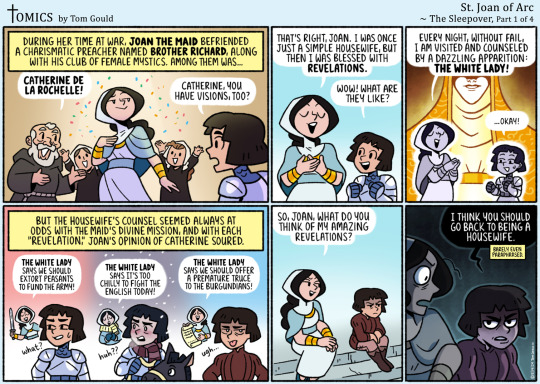
05/20/2024
"May of the Maid" continues with a story-arc featuring Joan's real-life rival mystic?!
___
JOKE-OGRAPHY:
1. The Source: This cartoon is based off people who are mentioned briefly in St. Joan of Arc's trial. Here are some relevant passages (translated by W. S. Scott):
1a. Extorting Peasants / Housewifery: "This Catherine said [...] that a woman appeared, a white lady, dressed in cloth of gold, who told her to go through the good towns, and that the king would give her heralds and trumpets to proclaim that whoever had gold, silver, or treasure should at once bring it forth; and that she would know those who did not and those who had hidden it; and would know where to find the treasure; and it would serve to pay Jeanne's men-at-arms. To which [Jeanne] had answered that [Catherine] should return to her husband, and look after her household and children."
1b. Too Chilly: "Asked if she had spoken to Catherine de la Rochelle concerning going to La Charité, [Jeanne] replied that Catherine did not advise her to go there; saying that it was too cold, and she ought not to go."
1c. Premature Truce: "[Jeanne] said also to Catherine, who wished to go to the Duke of Burgundy to make peace, that it was her opinion that they would find no peace save at the lance's point."
2. The Characters: Brother Richard was a Franciscan friar and a doomsday preacher. In 1429, he was prophesying the end times in 1430. He was incorrect, but before people knew that, his sermons stirred whole cities. He also seemed to try and befriend any female mystics (women with visions) he came across, probably to boost his legitimacy. Catherine de La Rochelle was one of these mystics. She and Joan might've started out as friends, but Joan eventually came to suspect Catherine of being a fraud and told the king so. As you might guess, that didn't go over well with Brother Richard or Catherine. It might be because their relationship ended on a sour note that Joan is so short in her answers to questions about them during her trial.
#catholic#christian#comic#cartoon#catholic memes#christian memes#tomics#tomics comics#tom gould#joan of arc#st joan of arc#jeanne darc#st jeanne darc#brother richard#catherine de la rochelle#sleepover#why is it called sleepover you ask#find out next time on#MAY OF THE MAID
346 notes
·
View notes
Text
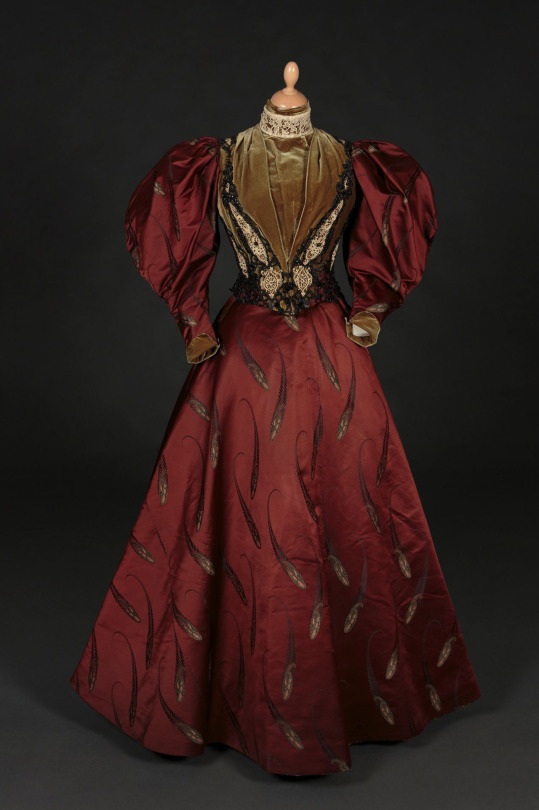
House of Paquin at the turn of the last century was drama, drama, drama. Paquin has always been one of my favorites, not for the least of which is the fact my own French family has the same last name. Jeanne Paquin, as she came to be known, however, was likely not a relation to me at all. She and her husband used the Paquin name. Though it is now synonymous with Paris Haute Couture, it's also one of the most common last names in Québec!
That said, this gown encompasses so much of what I adore about the last little bit of the Victorian era. It's intense. Intense colors, intense fabrics, intense flounces. Though we are firmly in the narrow-waist era, it's all about shape and proportion. As you're likely aware, those huge leg o'mutton or leg of lamb sleeves are, in fact, Gigot callbacks to the earlier part of the century.
Personally, I'm just enchanted by the burgundy wine hue on that silk, to say nothing of the intricacies of the bodice. Though the 1890s were very, very covered up, they still had an almost architectural brutality to some of the designs. Like, this IS the villain era, you know what I mean?
From Tessier-Sarrou.
#historical costuming#costume history#silk dress#costume#textiles#victorian fashion#fashion history#threadtalk#late victorian fashion#history of fashion
573 notes
·
View notes
Note
Do you see a similarity between Margery Tyrell (as well as Elinor Tyrell, Megga Tyrell, and Alla Tyrell) being put on trail and the trail of the daughter's in law of King Philip the Fair of France (specifically as described in The Accursed Kings), I was reading the Iron King a few weeks ago and it made me wonder if there was a connection as GRRM is a fan of the The Accursed Kings.
Me, think about a connection between ASOIAF and The Accursed Kings? Now when have I ever done that before?
(It me, it always me. Also long, more under the cut.)
Absolutely, I 100% believe that GRRM partially (emphasis on partially) based the supposed love affairs of Margaery and her cousins on the Tour de Nesle Affair as depicted in The Accursed Kings - specifically the first novel of the series, The Iron King. To very briefly summarize, the Tour de Nesle affair centers on the three daughters-in-law of King Philip IV of France: Marguerite of Burgundy, wife of Philip’s eldest son, Louis (and Queen of Navarre, since Louis is King of Navarre in his own right); Marguerite’s cousin Jeanne of Burgundy, wife of the king’s second son, Philip; and Jeanne’s sister (and, naturally, Marguerite’s cousin) Blanche, wife of the king’s third son, Charles. Marguerite and Blanche engage in extramarital sexual affairs with two courtiers, the brothers Philippe and Gautier d’Aunay, with Jeanne acting as facilitator and messenger for their trysts; the affair takes its name from the tower of the Hôtel-de-Nesle, the manor of the King of Navarre, where Marguerite and Blanche entertain their lovers. The affair is discovered by another French prince, Robert of Artois, and he and Philip IV’s daughter, Isabella, engineer a scheme to trap the princesses and expose them. Marguerite, Blanche, and Jeanne are subsequently caught and found guilty, the former two of adultery, the latter of aiding and abetting them; Marguerite and Blanche are imprisoned (the former until she is murdered, the latter until she dies, prematurely young and apparently insane), while Jeanne is likewise initially imprisoned but eventually freed by and reunited with her husband.
With respect to parallels between this story and the plot of AFFC, the Tour de Nesle affair and the affair Cersei invents for Margaery both involve several interrelated royal (or semi-royal) ladies. I mentioned above the princesses in The Iron King, who are called the “Princesses of Burgundy”: Marguerite is the daughter of the Duke of Burgundy, while her cousins Jeanne and Blanche are referred to as the “sisters of Burgundy”, daughters of the late Count of Burgundy. (Yes, the Duchy of Burgundy and County of Burgundy were at this time two separate political entities despite sharing a name). Likewise, the sexual scandal dreamed up by Cersei centers on four Tyrell girls at court, with one a queen: Queen Margaery, of course and three of her cousins, Megga, Elinor, and Alla. None of the Tyrell girls are sisters to any of the others, but all four are part of an extended Tyrell family, grouped together as “Tyrells” much as the three princesses of The Iron King are counted together by Robert of Artois as part of the “family of Burgundy”. In turn, just as Robert of Artois seeks to reveal the scandal specifically so that “[t]he whole family of Burgundy will be plunged up to the neck in the midden … [and] their inheritance will no longer be within reach of the Crown” - leaving that disputed inheritance open to Robert himself - so Cersei, furious at being “awash in roses”, dreams of framing Margaery for a crime of treason so serious that “even her own lord father must condemn her, or her shame becomes his own”.
Moreover, the parallel between these plots in The Iron King and AFFC is strengthened by the identities of the respective plotters. As I noted, one of the two chief architects of the plot against the princesses of Burgundy is Queen Isabella - daughter of King Philip IV of France, sister-in-law to the three princesses, and Queen of England as the wife of King Edward II. Just as Cersei is considered one of the most beautiful women in the Seven Kingdoms, inheriting the golden good looks of any number of Lannister antecedents, Isabella is often compared to her famously handsome father, Philip the Fair, sharing what Druon calls the king’s “legendary personal beauty”; a courtier of her father’s, Hughes de Bouville, even goes on to compliment Isabella in a later novel, The She-Wolf of France, by saying that Isabella had inherited “all [King Philip’s] beauty which was so impervious to time”. Yet The Iron King opens on Isabella by calling her “the loveless queen”, and it’s a description as fitting to Cersei as it is to the daughter of Philip IV. Just as Isabella is trapped in a miserable marriage to Edward II, so Cersei was trapped in a terrible marriage to King Robert Baratheon - marriages made by their respective fathers, for the political gains of their paternal families. Indeed, King Philip’s retort to Isabella’s complaints about her bad treatment at the hands of her husband - “I did not marry you to a man … but to a King. I did not sacrifice you by mistake” - seems like the sort of reply Tywin would have given to Cersei, having chosen to make his daughter queen and secure a future royal grandson despite privately dismissing Robert as a stupid oaf (to say nothing of Robert's years of abusing Cersei).
Likewise, both queens seek solace in their eldest sons, as well as their birth dynasties. Isabella is first shown approving that her baby son Edward’s first word was “want”, which Isabella calls “the speech of a king”; she also teaches her son that “he belongs to France as much as to England” and insists that he “get accustomed to the names of his relatives” and learn “that his grandfather, Philip the Fair, is King of France”. Isabella also surrounds herself with reminders of her French past: The Iron King opens with Isabella listening to a French poem, her most trusted lady-in-waiting is the French Jeanne de Joinville, and in a later novel, The She-Wolf of France, Isabella loses to her husband’s favorite a book of poetry by Marie of France. For her part, Cersei has made sure - or at least tried to make sure - that Joffrey was raised as a Lannister with no love for his Baratheon “father”; indeed, Cersei even likes to think of conceiving Joffrey with Jaime as an act of revenge against Robert while trapped at the home of Robert’s maternal family. Joffrey’s surcoat when he duels Robb at Winterfell shows the Lannister lion equal to the Baratheon stag, imagery he later makes his official standard when he becomes king, and he famously has in the first book a sword he proudly calls Lion’s Tooth; too, when he is married, the Lannister banners are displayed as equal to the Baratheon and Tyrell banners, underlining the Lannister importance in Joffrey’s reign.
Too, neither queen has much love for the eventual objects of their respective plotting. When Robert of Artois informs Isabella that the princesses of Burgundy “hate you”, Isabella replies that “[t]hough I don’t know why, it is true that as far as I am concerned, I never liked them from the start”; Robert then adds his opinion, that Isabella “didn’t like them because they’re false, because they think of nothing but pleasure and have no sense of duty”. Indeed, Isabella’s longstanding dislike and distrust of her sisters-in-law seems reflected in her suspicions, apparently established before the beginning of The Iron King, that the princesses were already deceiving their husbands with extramarital lovers, seemingly heightened by the contrast to her own faithful (for her part) but loveless marriage - Isabella later tells Robert that “when I think of what I am denying myself, what I am giving up, then I know how lucky they are to have husbands who love them”, declaring “[t]hey must be punished, properly punished!”. Cersei’s distrust of Margaery, of course, can hardly be overstated, though in her case the origins of her hatred stem not from Margaery herself but rather Cersei’s paranoia about her, Cersei’s, own prophesied downfall at the hands of a younger and more beautiful queen. Convinced - probably at her ultimate cost - that her son’s (or sons’) eventual wife would fulfill the prophecy Maggy gave so many years prior, Cersei was predisposed to dislike, distrust, and deeply fear such a woman from the first
So both queens set out to denounce and bring down their royal in-laws through the revelation of a sexual scandal - the bombshell news that a queen and her aristocratic cousins have taken lovers in the persons of a few highborn courtiers. Both plots begin at their outset with the queens appointing spies in the households of the targets of the plots. Robert of Artois advises Isabella to request one of his allies be placed in Marguerite’s household as what he terms “a spy within the walls” - a successful move for Robert and Isabella's conspiracy, as not only does Marguerite (correctly) suspect Madame de Comminges for “always trailing about in her widow’s weeds”, but Robert also reveals that “[s]ince entering Marguerite’s service, Madame de Comminges sent him a report every day”. Cersei herself recruits Taena Merryweather from Margaery’s own household, blithely confirming Jaime’s suspicion that “[s]he’s informing on you to the little queen by saying that “Taena tells me everything Maid Margaery is doing”. Taena, for her part, tells Cersei what Cersei wants to hear, often dropping sexually suggestive hints supposedly about Margaery and her court, which encourage Cersei in her plot against Margaery.
Additionally, each queen faces the difficulty in singling out the rival queen in question given the presence of those rivals’ respective ladies. Robert of Artois complains that the princesses of Burgundy are “[c]lever wenches” because while Jeanne or Blanche often go to “pray” with Marguerite at the Tour de Nesle, each acts as an alibi for the other; as Robert concludes, “[o]ne woman at fault finds it difficult to defend herself”, but “[t]hree wicked harlots are a fortress”. Indeed, Taena Merryweather borrows almost the exact same castellated metaphor from Robert, claiming that Margaery’s “women are her castle walls”, as “[w]henever men are about, her septa will be with her, or her cousins”. This commentary from Taena inspires Cersei to ponder whether “[Margaery’s] ladies are part of it as well … [sic] not all of them, perhaps, but some” and then manipulate the confession of the Blue Bard to implicate Elinor, Megga, and Alla in the invented affair.
So in both cases, the groups of royal ladies are accused of fornication, with one lady from each excepted for a charge of what we might call criminal knowledge instead. In the case of the princesses of Burgundy, it is Jeanne who is deemed “guilty of complicity and culpable complacence”, while in the case of the Tyrells it is young Alla who is “charged with witnessing their shame [i.e. the supposed sexual relationships of Megga, Elinor, and Margaery] and helping them conceal it”. The distinction in charges notwithstanding, all the ladies are thereafter imprisoned, with both the Burgundy princesses and the Tyrell ladies stripped of their finery: at their judgment, the princesses of Burgundy kneel before the king “shaven and clothed in rough fustian” (so humbled that Jeanne and Blanche’s mother mistakes them for “three young monks”), and when Cersei visits the imprisoned Margaery, the young queen is dressed in “the roughspun shift of a novice sister”, with “[h]er locks … all a tangle”.
(It’s probably going too far to suggest that the planned roles for two courtier brothers in Cersei’s plot echoes the involvement of the d’Aunay brothers in the Tour de Nesle affair. After all, only Osney of the three Kettleblacks was supposed to have had sex with Margaery, and only Osney did have sex with Cersei, whatever Cersei would later claim to the High Septon.)
(I would be amused if GRRM named Margaery after Marguerite of Burgundy, knowing perhaps he would use her in an Accursed Kings-like plot in the future. However, I’m not saying this was necessarily or even likely the case: Margaery had been named since AGOT, after all long before the writing and publication of AFFC, and while GRRM’s affection for Maurice Druon and The Accursed Kings predates ASOIAF, there is no evidence that he planned this sort of parallel all the way back in 1996. The similarity of names may be simply an amusing coincidence, or even a retroactive realization by GRRM that he could use a similarly named character to star in a plot directly inspired by Marguerite of Burgundy’s story.)
Now, does this mean GRRM limited himself to The Iron King in creating this plot point for AFFC? Absolutely not, I would say. Indeed, I think it is very clear that GRRM also looked to the popular conception of the downfall of, and all but certainly false accusations leveled against, Anne Boleyn for further inspiration. Here, as in the popular imagination of Anne’s undoing, is a queen accused of sexual affairs with several male courtiers, who are imprisoned along with her (though note that according); here, as in the trial of Anne Boleyn, is a singer, supposedly among those accused lovers, tortured into a presumably false confession (and being the only accused lover to confess); here, as with Anne and George Boleyn, is a charge of incest against a queen and her brother, so obviously ludicrous in both cases that no contemporary takes it seriously; here, as with the arrests and subsequent release of Thomas Wyatt and Richard Page, are two courtiers seemingly accused of the same crime, but expected to be freed in order to demonstrate the guilt of the others. It’s an obvious but important point that GRRM does not need to borrow only to one point of inspiration, fictional or historical (or, rather, what he imagines as historical), for any given narrative he wants to write. Drawing connections between The Iron King and the plot against Margaery and her cousins no more invalidates connections between that same plot and the popular conception of Anne Boleyn’s downfall than comparing, say, Baelor to Louis IX of France (including the latter’s depiction in The Accursed Kings) invalidates comparisons between Baelor and Henry VI of England.
This last point extends to Cersei herself as well. While I definitely believe GRRM borrowed elements from Isabella of France for Cersei, I have also argued, and still believe, that Cersei also shared elements of her character and story with Marguerite of Burgundy herself. Parallels between Cersei and Marguerite should not nullify or undermine parallels between Margaery and Marguerite (specifically in this context of affairs/supposed affairs), any more than parallels between, say, Edward IV of England and Robert Baratheon should nullify or undermine parallels between that same King Edward and Robb Stark (specifically in the context of a secret marriage with no apparent political benefit). GRRM is not required to neatly match one for one a character in his universe to a historical or fictional figure, nor would I think we as readers would want him to; it would be a pretty boring story if he simply copy pasted figures from extant works or history and swapped their names for those he created.
Plus, I think Margaery and her cousins are pretty likely to come out of their trials much better than the princesses of Burgundy did with theirs. Most obviously, as even the High Septon admitted, the case against the queen and her cousins is weak - as indeed it might be, given that Cersei invented the affair in the first place. Far from the d’Aunay boasting about their royal lovers by wearing the infamous purses given them by the princesses (and gifted to them by Queen Isabella, to catch the lovers with them), all of the supposed lovers of the Tyrell girls save the Blue Bard have denied the affair, and his testimony is denounced as “half-mad”. On a practical level, the High Septon surely knows the danger for him, and his position, of convicting Margaery, given that Osney reported on the crown of sparrows demanding Margaery’s release (news Cersei regards ruefully, since as she thinks “Margaery has been their little pet”). Add to that threat the presence of Mace at the head of his army, returned to the capital explicitly to see through his daughter’s trial, and the High Sparrow is playing with fire in truly trying to convict Margaery and her cousins.
46 notes
·
View notes
Text








Medieval Women Week || Favorite Queen or Queen-adjacent ↬ Jeanne “la Boiteuse” de Bourgogne
Philip VI’s relentless persecution of Robert of Artois long after the man had become a broken and impoverished exile is revealing of his character. No doubt much of the venom was due to the influence of the Queen (the Duke of Burgundy’s sister). Philip himself, although he was not by nature a vindictive man, was an extremely superstitious and unconfident one. He took most seriously the threats which Robert hurled at him from abroad to foment rebellion in France and to strike down his children by sorcery. — Trial by Battle: The Hundred Years War, vol. 1 by Jonathan Sumption Philip VI’s queen, Jeanne, was the sister of the duke of Burgundy and headed a faction at court. A contemporary chronicler wrote about her: “the lame Queen Jeanne de Bourgogne... was like a king and caused the destruction of those who opposed her will”. — The Valois: Kings of France, 1328–1589 by Robert J. Knecht
#medievalwomenweek#joan of burgundy#house of valois#french history#european history#women's history#history#medieval#house of burgundy#nanshe's graphics
25 notes
·
View notes
Text

The Death of John of Lancaster, Duke of Bedford - 14 September 1435
Bedford died in Rouen Castle on 14 September 1435 at a critical moment in the war, a week after the English left the congress of Arras unsatisfied in their demands, and a week before the conclusion of peace between France and Burgundy. On 13 April 1436 Paris was reconquered and English possessions, including Bedford's, were confiscated for the crime of lèse-majesté. Normandy was lost by 1450 and by 1453 all France except Calais. In accordance with the provisions of Bedford's nuncupative will, he was buried 'magnificently' on 30 September in Rouen Cathedral, on the north side of the choir near the high altar, near the other royal tombs. His effigy was destroyed by Calvinists in 1562, but a funerary plaque bearing his arms, heraldic insignia, and Garter collar survived to the eighteenth century [...] The burial was excavated in 1860. A large-framed skeleton was reportedly uncovered, fitting with Waurin's description of Bedford at Verneuil as a man of great physical strength with powerful limbs. [...] He left no legitimate children, but two bastards, Richard and Mary, apparently conceived before the regency. Their mother is unknown. [...] Bedford's reputation survived the reconquest of France and Normandy. His familia and former captains, such as Sir John Fastolf, are recorded in William Worcester's Boke of Noblesse as lamenting the passing of the regent and what he stood for. In his own century many English and French (especially pro-Burgundian) chroniclers eulogized Bedford; Thomas Basin described him as 'wise, humane and just' (Basin, bk 2, cap. 2). Lively pen portraits of Bedford and Anne of Burgundy are sketched by the Norman chronicler Pierre Cochon and by the anonymous Parisian, the Bourgeois de Paris, who wrote approvingly of Bedford's propensity to build (maçonner) wherever he was. His hot temper emerges in a few episodes, as does his religious orthodoxy. [...] Criticism of Bedford and the regency has been strongest from nationalistic historians of Normandy and partisans of Jeanne d'Arc, in line with the historiography of the Hundred Years' War as it developed in the nineteenth century. Most historians have emphasized his devotion to duty, to his dead brother's intentions, and to the service of his nephew Henry VI. Bedford was a mighty prince, a brave soldier, and a considerable patron and collector. His court and its ceremonies fulfilled a crucial political role in giving an illusion of permanence and stability to the Lancastrian presence in France.
Jenny Stratford, "John [John of Lancaster], duke of Bedford (1389-1435), Oxford Dictionary of National Biography
#otd#john duke of bedford#historyedit#why does his anniversaries always sneak up on me#historian: jenny stratford#edits
34 notes
·
View notes
Text
Isolabella Duvessa Tsukii
☾The Undead 1st Vice Warden of Sapphire Lake. A stoic and cool headed woman with a hidden golden heart. Maybe she will learn to smile more often with the feeling being judge or watch constantly

╭──・ Basic Information
Name: Isolabella Duvessa Tsukii(She still prefers to be called Tsukii)
Romaji: Tsukii Duvessa Isolabella
Quote: "It is always a pleasure to break someone's ego for pettiness.."
V/A: Eirene from Path to Nowhere(Japanese), Stargazer from Path to Nowhere(English), and Oak Casket(when her sadist side appears and in both Eng and JP)
Gender: Female
Sexuality: Pansexual
Age: 21
Birthday: January 23rd
Zodiac Sign: Aquarius
Eye color: Crimson red with purple hue
Hair Color:Dark burgundy red hair with dark purple ends
Height: 5'7
Weight: 102 lbs
Race: Undead vessel(Irl wise: She is biracial)
Homeland: Yokohama, Japan
Family:
Dexion Tsukii- CEO Egyptian/Black Father
Hanako Tsukii- College Professor Japanese Mother
Ryuki Malik Tsukii-1st older brother
Kurayami Tsukii-2nd older brother
Hideki Tsukii- 3rd older brother(Adopted)
Akeldama Tsukii- 4th older
Saito Mun- Her shapeshifter pet
SunHi & Anzhong- Fraternal Twin cousins
╭──・ School Information
School Status and Fun Fact
Dorm: Sapphire Lake Dorm
School Year: 2nd year
Class: 2-B
Student Number: No.23
Occupation: A DJ and babysitter after school
Club: Light Music Club
Best Subject: History and Flying(in NRC), Music and gym(in Yuu's world)
╭──・ Interests
Favorite Color: dark and pastel colors
Favorite Food: sweets, homemade food, and some food Jamil made(which she had Dawn steal for her due to her and Jamil having that silent beef towards each other)
Least Favorite Food: Maggot cheese, Liver, and Lilia's cooking,
Likes: alone time, reading, coffee + tea, rainy days, walking around in the cold, the night sky, stargazing, RSA(she will never understand the relationship between NRC and RSA), dad jokes, music, her friends and family, keeping secrets
Dislikes: Crowley, loud noises, Ace's boldness, losing her temper, her bad moods, seeing her objects went missing, Octo Trio(she only tolerates them), some of the members from different dorms boss her around, Sebek's yelling, Rook
Hobbies: dance and play the violin in the rain
Talents: Room reader, empathetic, knows someone is lying by a glance, walk in the dark
╭──・ Other information
Nicknames: Tsu-Tsu(the Libya twins and Jeanne), the silent bookworm(Jamil), La princesse des esprits or La déesse des esprits(Rook)
Other Nicknames: Psycho(family only), white rose(childhood nickname)
Mutual Ocs nicknames
@kousaka-ayumu
Tsu-chan by Sonomi
Tsukii(Everyone else)
Tsukii-chan by Yuri
@yumeko2sevilla
Tsukii-Senpai by Yukiharu
Tsu-Senpai by Erin
The Spiritual Goddess of the Clockworker by Yukikaze
@queen-of-twisted
Tsu-Tsu by Minako and Akane
Big Sister Tsukii by Pierre and Alaida
Duvessa by Florence
Goddess of Spirits by Esther
Appearance and Personality:
Appearance: she had long dark burgundy hair that had dark purple ends, her eyes are crimson with a mix of purple. She had a light tan skin with a few scars here and there. But her signature items are a cross earring,her choker, and her fingerless gloves
Personality: Reserved with a sadistic side is what people describe Tsukii in her personality. She is very reserved and secretive with her family and past. It never helps since Tsukii is an ambivert(she leans more into an introverted side). Due to this, people often thought that Tsukii would let people push her around but she doesn't. She is bold and harsh with her words. She is a fighter and feisty plus she is a lot confident with herself after years of being pushed around because of her silence. But underneath all of that lives a woman who had a hard time opening up due to her past with a heart of gold
Trivia:
She is the only female who had the gut to punch Malleus(He scared her)
She used to wear glasses but not anymore
She still never got used to praises and compliments
Multilingual but chooses certain languages for certain people
She is a younger sister of Blood Rose(aka Akeldama Tsukii)
She is more...sadistic with her words than actions
In middle school: She has a violent streak when she is pushed past her limits.
✶ Unique Magic
⟡Name: Dance of the Damned Afterlife
⟡Chant: "The spirits are singing in harmony, dancing and cheering in pain and agony...towards the gates of the afterlife. Join the dance of the Dead! Dance of the Damned Afterlife!!"
⟡Description: Tsukii will send the person to the alternative reality in the cemetery where the dead surrounds you and began to dance towards the cursed gates of the afterlife with the person in tow. Once in the dance, there is no escape.

The Undead Vessel is praying for the dead of the dorm but never disrespect the dead. The dead and her will not be pleased with the disrespect.
“Your soul…both dark and light…but no humanity. Your soul is way more darker than the darkest of souls but the purest of souls. You’re more intriguing than the rest. Sapphire Lake Dorm. No dorm fits her better than Sapphire Lake. The SPIRITS need their guide after all.” Dark Mirror to Tsukii
3 notes
·
View notes
Text
This looks really cool ngl

A fully illustrated study of the French armies that were inspired by Saint Jeanne d'Arc, reformed under King Charles VII and eventually victorious over England in the Hundred Years' War. Saint Jeanne d'Arc remains a central figure in France's national legend, having ushered the country's flagging military forces into a period of extraordinary reform and revival that culminated – some 22 years after her death – in the French emerging triumphant from the Hundred Years' War. France's 1429 victory at Orléans, which was headed by Saint Jeanne, marked the first major setback to a long series of English successes and led directly to the coronation of King Charles VII, who would transform France's fortunes by making peace with Burgundy, gathering foreign allies and creating permanent armed forces under royal control. In this engaging new study, French military historian Philippe Gaillard examines the events and individuals that brought about such a pivotal shift in the trajectory of medieval France. Combining detailed research with period illustrations, artefact photography and newly commissioned artwork plates, the author brings to life the story of Saint Jeanne d'Arc, the army she revitalized and the structural and tactical changes that carried King Charles VII and France to victory at Formigny and Castillon in the 1450s.
7 notes
·
View notes
Note
hai ari whats ur dream fashion style? not like what you dress like now, but what u wish u could wear? :33
Well, 15th century armour of many varieties...
This is the early 15th century style -note the smooth, short breastplate and the relatively long fauld or 'skirt of plates' to protect the lower abdomen. This is the kind of armour that would have been worn by Jeanne d'arc, and indeed her English enemies.

The early 15th century is also where we start to see the dying out of cloth coverings for most soldiers, like these rather fetching fellows and their excellent tabard. There's a move towards bare metal as the 1400s progress.
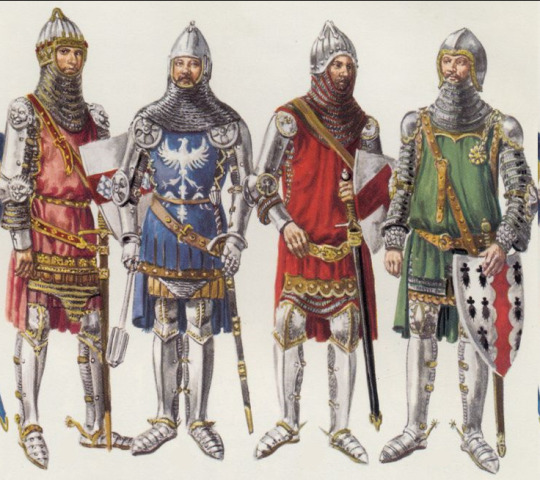
Further forward we see the Burgundian style come into its own, and I really do like their look. I do love me some brigandine, something like what the fellow in white is wearing.
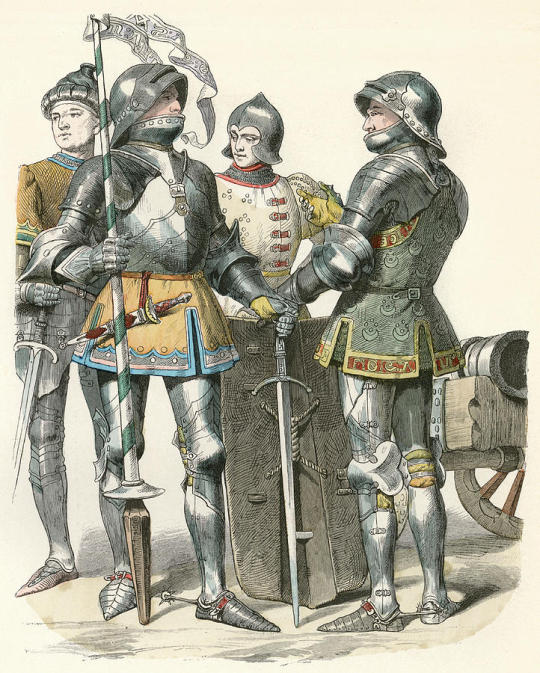
Something that also appears in Burgundy are various depictions of the armour people belived the great heroes of the past wore -this is fantasy armour in a time when plate armour was arguably at its peak importance, and it looks cool as fuck.

Following this, we have the pinnacle of the German Gothic style. And goddamn is that shit sexy.
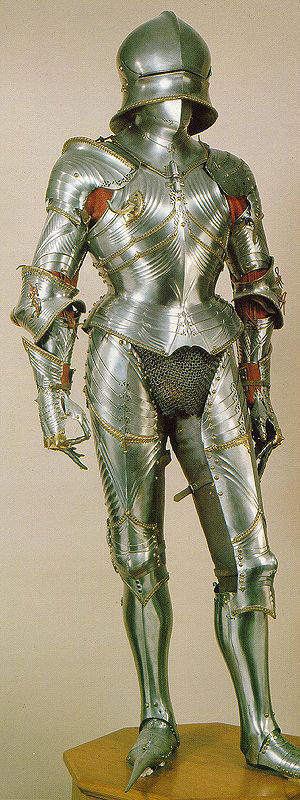

Special mention to brigandine again. That shit slaps So hard, it's almost as proctective as full solid plate (there's not much in it), it's more flexible and it looks SO GOOOOOD like look at this shit


(this is a more fantastical design but it still holds up)

Plus, they can get SUUUUPER fancy too!

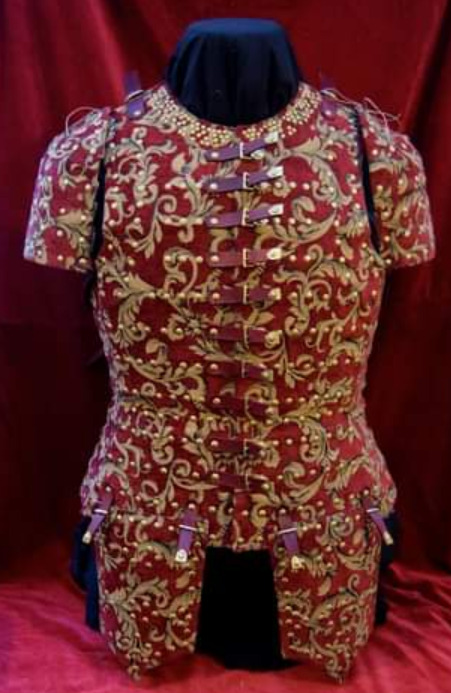
The second of these isn't a super high quality image but I've seen it in person and it is stunning. The fabric it uses is actually an off-cut from the late Queen Elizabeth II's sofa!
Plus, special mention to chinese brigandine armour, of which there are so many cool styles. this is a Ming dynasty example, and man I gotta learn more about chinese arms and armour it looks cool as shit

Aside from medieval armour, I do very much dig the sorta fantasy-piratical aesthetic. Tall boots, corsets, funky hats, big long flowing coats and frilly shirts... What's not to love!?
9 notes
·
View notes
Text
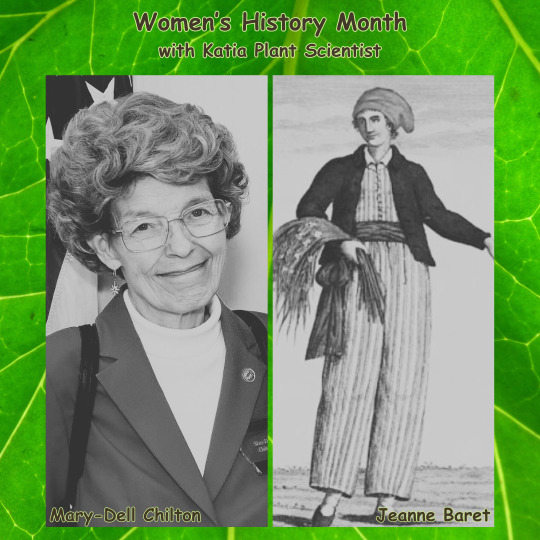
Meet more inspiring women from the world of plant science in honour of Women's History Month 2024!
Mary-Dell Chilton
Modern plant biotechnology would not be possible without the groundbreaking discoveries of Mary-Dell Chilton ( February 2nd, 1939 – present). Much of plant genetic engineering relies on the microbe Agrobacterium tumefaciens to insert genes of interest into the host plants’ genetic code to produce transgenic plants in subsequent generations. This was not possible before Mary-Dell Chilton found the crucial link between Agrobacterium and modification of plant DNA in 1977 by modifying the bacterial plasmid responsible for gene transfer. She has authored over 100 scientific publications and won numerous awards over her long career.
Jeanne Baret
A swashbuckling French woman who lived part of her life disguised as a man, Jeanne Baret (27 July 1740 – 5 August 1807) was a botanist in the crew of explorer Louis Antoine de Bougainville’s voyages which circumnavigated the globe between 1766 and 1769. A person from humble peasant origins in Burgundy who was orphaned by age 15, Jeanne became the housekeeper and later life partner of botanist Philibert Commerson. As part of the expedition's crew, the couple discovered and scientifically described many new plant species in South American, Southeast Asia, and Oceania. However, women were not permitted on French navy ships in the 18th century so Jeanne disguised herself as a man to accompany her partner.
#katia_plantscientist#history#womenshistorymonth#womenshistorymonth2024#marydellchilton#jeannebaret#womeninscience#womenscientists#botany#historyofbotany#botanist#agrobacterium#agrobacteriumtumefaciens#swashbuckling#explorer
#katia plant scientist#botany#plant biology#plants#plant science#agrobacterium#genetic engineering#explorer#adventurer#women in science#women in history#women scientists#womens history#women's history month#historical figures
3 notes
·
View notes
Text
The Sea Miracles

Summary: Opposites attract. It is the term used for people who are complete opposites meet and fall in love. Well the saying is true but what would two people from different dorms meet. Love is a unique thing indeed.
Shipping: Daniel x Tsukii
AN: Daniel belongs to @yuuniee
Words: 902 words
Warning: Fluff, strangers to friends, friends to lovers, Tsukii being her secretive self, doubt about themselves(Tsukii), Jeanne being a wingman, a bit of angst but mostly fluff :3

People find love in mysterious ways.
Not only is the saying true and it makes two different people fall in love. In more ways than one. Daniel Jett Sterling had fallen in love with Isolabella Duvessa Tsukii aka Tsukii, the first vice warden of NRC’s Sapphire Lake Dorm.
How they meet is interesting to say the least. Daniel and Tsukii met during after class hours, they both bump into each other and Tsukii was the one to apologize for not paying attention as she was reading a book. “Hey..I apologize for bumping into you. I really should put my book away more often.” The girl said with a nervous smile as she was embarrassed of her actions. The merfolk just look at her in awe. He was taken back by her beauty and her appearance. He never saw any woman who had those features but her. Her burgundy red hair with light purple shaded ends, light tan skin, her eyes are heterchomia but her eyes have crimson red and amethyst purple colors in them.
Daniel snapped out his trance when he noticed the girl was staring at him in worry. “Eh. It's no biggie. I’m Daniel. Daniel Jett Sterling.” Daniel introduces himself as the girl looks at him in curiosity before introducing herself back. “My name is Isolabella Duvessa Tsukii. It is a pleasure to meet you Daniel. Call me Isolabella or Tsukii.”
After that day, Daniel and Tsukii usually see each other at random times with random people. But they share common interests, one of them is music. Daniel is a DJ while Tsukii is a DJ too but she plays a different type of music with Daniel but she never likes showing her face towards fans or in public outside of NRC. Daniel noticed that the bookworm only comes to Octavinelle for drinks and some food and nothing else. He also noticed that she always has a book with her, knowing why she is called the silent bookworm by everyone in NRC. Daniel was the first one to take her order and even delivered her food, making small conversations with the said girl. Tsukii was shocked when Daniel has misophonia but she understands and shares a bit of information. She has a fear of being taken advantage of because what happened to her when she was younger, she ended vowing to close her heart so she will be okay. Daniel ended up vowing to treat Tsukii like a queen she is. Tsukii and Daniel are both careful with their actions and words towards each other, making sure that they are both okay.
Tsukii was in denial about her feelings for Daniel as she worried about her heart breaking again. She was taken advantage of by so many people..that she had to close her heart away so she won’t be hurt again. But she knows that Daniel loves her but she knows that she never gets her hopes up. That is the lesson she learned years ago. As time passed, Daniel and Tsukii grew closer as everyone in NRC was confused and shocked when they saw Daniel and Tsukii together but the silent bookworm only gave vague answers which not only annoyed people but it made them want to know more. Daniel wanted to ask Tsukii out but he ended up overhearing Tsukii tell her close friends that her birthday is coming so she was excited for it. He later asks Jeanne when’s the girl’s birthday and he has the answer he needs. “January 23rd is her birthday. Why?” Jeanne asked Daniel with a sly smirk, making the male blush and confessed that he was planning to ask Tsukii out.
The mirror demon told Daniel a place in Sapphire Lake Dorm where Tsukii hangs out which is the gardens and told him where to find it. Daniel was excited but scared to be rejected by Tsukii but Jeanne reassures him that Tsukii may look cold but she is a sweetheart underneath the cold mask. She is positive that Tsukii will return his feelings. When Tsukii’s birthday comes, Daniel asks Tsukii to show the gardens which the girl happily shows him the way. Daniel loves the way Tsukii shows him Sapphire Lake Dorm and he will admit..Sapphire Lake Dorm is unique just like her. The two arrived at the garden and just relaxed there. Daniel decided to confess to Tsukii and closed his eyes in fear but..Tsukii spoke. “Silly. I love you too.” She smiles at him with her cheeks red and she is actually crying tears of joy. Daniel held her close to him and they both shared their first kiss.
In the background, Jeanne is watching the scene with a warm smile on her face. “I told you that you will find someone who loves you for who you are, Tsu-Tsu. You already found that person.” Jeanne leaves the scene with teary eyes, happy for Tsukii to find her love,proud of herself to tell Daniel about the garden and now wishes for the two to overcome anything together.
Love is agonizing but patient. That is Tsukii's new lesson. She found someone that sees her for herself and nothing else. This makes the silent bookworm drop her mask and smile warmly with tears of joy and happiness. ‘Finally..I can’t hide behind a mask anymore..I'm happy.’ Tsukii smiled at the thought. What a beautiful birthday gift.

#the archiver writes#oc x oc#the hidden mansion#writing masterlist#my writing#Isolabella Tsukii#Daniel Jett Sterling
7 notes
·
View notes
Text





Unfortunately, there's nothing I can do to to pretend that this is something fun like Veronica setting up a meeting to murder Vanitas before her wine club meets to judge the new Burgundies or something like that, I have to know that it's having a date with jeanne.
I have never seen this show and know absolutely nothing about it! As that is the fun of having me liveblog this, please let it be fun for EVERYONE by not confirming denying, hinting, saying things like “oh just wait til episode x’, telling me about outside interviews, or anything that is cultural or historical that I’m not picking up on! PLEASE LET ME BE A STUPID PIECE OF SHIT
5 notes
·
View notes
Text
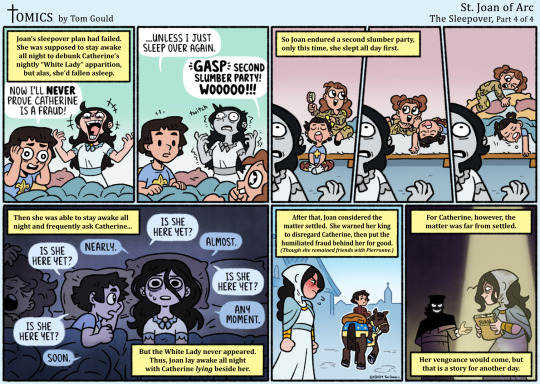
05/31/2024
Continuing from the previous cartoon, St. Joan of Arc's sleepover reaches its THRILLING CONCLUSION?! (Yes, this is based on an actual true story.)
___
JOKE-OGRAPHY:
1. Source: After all this time, we finally see the full picture. Now witness the full source from which this ridiculous-but-more-or-less-authentic story arc was spawned -- a portion of St. Joan's trial (translated by W. S. Scott): "Asked if she knew Catherine de la Rochelle, or had seen her, [Jeanne] said yes, at Jargeau; and at Montfaucon-en-Berry. Asked whether [Catherine] had shown her a woman dressed in white, who she said sometimes appeared to her, [Jeanne] answered no. Asked what she said to her, [Jeanne] answered that this Catherine said to her that a woman appeared, a white lady, dressed in cloth of gold, who told her to go through the good towns, and that the king would give her heralds and trumpets to proclaim that whoever had gold, silver, or treasure should at once bring it forth; and that she would know those who did not and those who had hidden it; and would know where to find the treasure; and it would serve to pay Jeanne's men-at-arms. To which she had answered that she should return to her husband, and look after her household and children. And, in order to be certain of the truth, she had spoken to Saint Catherine and Saint Margaret, who told her that this Catherine was mad and a liar. So she wrote to her king that she would tell him what ought to be done. And when she arrived, she informed him that Catherine was only a fool and a liar. However, Brother Richard wanted them to set her to work, which she [Jeanne] would not permit, wherefore Brother Richard and Catherine were displeased with her. Asked if she had spoken to Catherine de la Rochelle concerning going to La Charité, [Jeanne] replied that Catherine did not advise her to go there; saying that it was too cold, and she ought not to go. She said also to Catherine, who wished to go to the Duke of Burgundy to make peace, that it was her opinion that they would find no peace save at the lance's point. She also asked Catherine if this Lady appeared every night; and if so, she would sleep with her. And she did so, but kept awake till midnight; saw nothing, and then went to sleep. And when morning came, she asked if the Lady had appeared. And [Catherine] answered that she had come, but [Jeanne] was asleep, and she had not been able to wake her. So [Jeanne] asked her if the Lady would come the next night. And Catherine said yes. On this account Jeanne slept during the day in order that she might keep awake at night. And she shared Catherine's bed again the following night, and kept awake throughout the night. But she saw no-one, although she often asked, Will she come soon? To which Catherine answered, Yes, soon."
2. Explanation: In short, Joan met Catherine, and while the two might have gotten along at first, their visions eventually told them very different things, and Joan started to distrust Catherine. Eventually, Joan asked Catherine if her visions were visible to everyone and if they would appear every night. Catherine said yes, so Joan stayed over to see the vision. After falling asleep at midnight the first night, she managed to stay away the whole second night, but saw nothing. She took this to mean Catherine was a liar and a madwoman, and that was that.
3. Pun: In the fourth panel, the second narration says that Catherine was "lying" beside Joan. There are two kinds of "lying": one means "resting on a surface," and the other means "deliberately saying something untrue." Because Catherine is lying (resting) on a bed, but also lying (untruthing) to Joan about the White Lady, both definitions are valid AND grammatically correct. Hence, this is a perfect pun, and I demand all due compensation.
#catholic#christian#comic#cartoon#catholic memes#christian memes#tomics#bible#tom gould#tomics comics#may of the maid#joan of arc#st joan of arc#jeanne darc#st jeanne darc#pierronne#pierronne the breton#pierronne the bestie#catherine#catherine de la rochelle#catherine de la rochTRAITOR#wait wait#catherine de la ROACHelle like as in COCKROACH#horse#horse with the mean side eye#sleepover#slumber party
201 notes
·
View notes
Text
SAINT OF THE DAY (August 12)
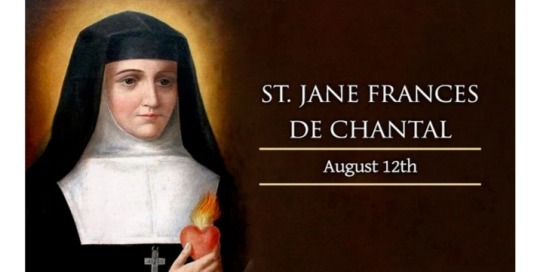
"In Madame de Chantal I have found the perfect woman, whom Solomon had difficulty finding in Jerusalem."
— St. Francis de Sales, her spiritual director
Jane Frances de Chantal was born on 28 January 1572 in Dijon, France.
She died at the Visitation Convent Moulins on 13 December 1641.
Jane (Jeanne) was born into nobility, her father being the president of the parliament of Burgundy.
At age 20, she was married to the Baron de Chantal. Jane had four children.
She loved and served her young family deeply until the death of her husband in a hunting accident at age 28.
For seven years, she was forced to live in the house of her father in law, a trial which she was forced to bear patiently due to his ill-disposition towards her.
It was also during this time that she took a vow of perpetual chastity.
In all of her prayers, Jane asked God to send her a guide. In a vision, He showed her the spiritual director that He held in reserve for her.
During Lent, in 1604, she visited her father at Dijon, where St. Francis de Sales was preaching at the Sainte Chapelle.
She recognized in him the mysterious director who had been shown to her, and she placed herself under his guidance.
Then began the famous correspondence between the two saints, which produced volumes of letters of spiritual direction, some of which are available today.
However, most of which were destroyed by her upon the death of St. Francis.
She went to Annecy in 1610, where she believed God was calling her to found an order for women and girls who felt called to live the life of Christian perfection but not practice the severe asceticism of the religious orders of the time.
Thus, the Congregation of the Visitation was canonically established at Annecy on 6 June 1610, Trinity Sunday.
The method of spiritual perfection of the Visitation nuns was that of St. Francis, which consisted in always keeping one's will united to the Divine will, in taking — so to speak — one's soul, heart and longings into one's hands and giving them into God's keeping, and in seeking always to do what is pleasing to Him.
There were 86 convents of the Visitation nuns at the time of her death 31 years later.
St. Jane Frances de Chantal's spirituality was a strong and resilient one; she did not like to see her daughters giving way to human weaknesses and encouraged constant battle against the passions and habits, which keep one from following God's will.
Her trials were continuous and borne bravely, and yet she was exceedingly sensitive.
She endured interior crosses which, particularly during the last nine years of her life, kept her in an agony of soul, from which she was not freed until three months before her death.
Her reputation for sanctity was widespread. Queens, princes, and princesses flocked to the reception-room of the Visitation.
Wherever she went to establish foundations, the people gave her ovations.
"These people," she would say confused, "do not know me - they are mistaken."
Her body is venerated with that of St. Francis de Sales in the church of the Visitation at Annecy.
She was beatified by Pope Benedict XIV on 21 November 1751. She was canonized by Pope Clement XIII on 16 July 1767.
6 notes
·
View notes